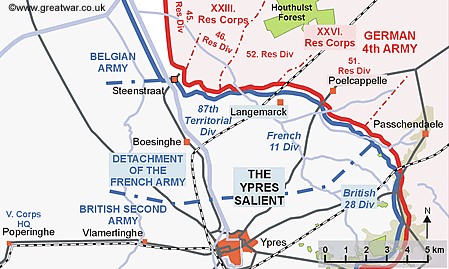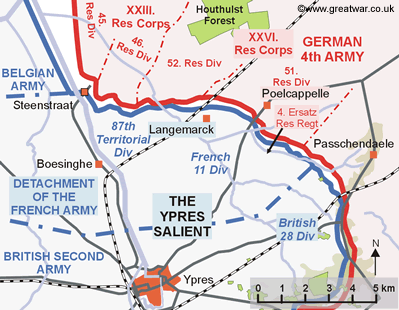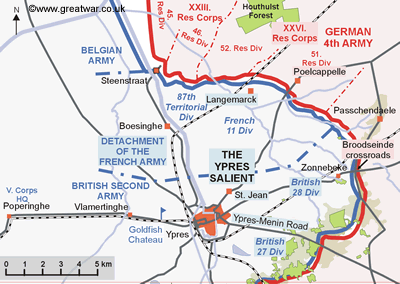 The British react to warnings of gas
The British react to warnings of gas
15 April 1915
Two Messages from the French
General Ferry's message from the French 11th Division, warning of a possible attack on the Allied line with gas, was received by the British 28th Division on Wednesday 14th April. It was then relayed to the headquarters of the British V. Corps in Poperinghe that same day.

The following morning, Thursday 15th April, the general commanding the British V. Corps, Lieutenant-General Sir Herbert Plumer, was informed of a message from the French via 28th Division. The message contained information about how the gas cylinders worked and included some of the cotton material taken from Private Jaeger's mouth protector:
“... German prisoner further stated that the gas bottles or cylinders are fitted with rubber pipes running forward towards hostile trench AAA Cylinders are deeply buried in front trenches AAA Battery personnel and others provided with special package of tow on cotton waste for use as protective mask AAA Sample of this cotton waste herewith for analysis if desired received to-day from French Division AAA Prisoner stated that the front intended to be attacked by means of asphyxiating gas on the first favourable opportunity extended from LANGEMARCK to POELCAPPELLE - WIELTJE Road and probably also further south AAA” (1)
The message also said that Jaeger spoke of a dress rehearsal for the attack, which was to have taken place on 13th April without the gas. The French 11th Division had confirmed that three red lights had been seen behind the German lines at about 01.00am on the morning of 14th April. Possibly this was part of the rehearsal for the German attack.
A second message was sent to V. Corps from the British 28th Division containing additional information about the German guns. The French had reported new types of German aircraft:
“German prisoner JAEGER ... gave further details on interrogation AAA Four ZEPPELINS were brought to GHENT during the last few days preceding capture AAA Three squadrons each consisting of eight aeroplanes one captive balloon and one battery anti-aircraft guns had recently arrived AAA One Squadron at STADEN one at HOUTHULST village and one at RUMBEKE AAA RUMBEKE is probably not that at X. Sixteen but more probably other RUMBEKE near SLEGHAGGE Q. twenty seven. One biplane seen by 11th Division on eleventh instant was reported to resemble British pattern so closely that it was not at first fired at AAA Subsequently black maltese crosses were seen AAA Prisoner described how German Automobile anti-aircraft gun is provided with automatic loading arrangements AAA Long gun AAA capable of being turned completely round horizontally on central pivot and capable of elevation or depression through large arc AAA also provided with double sighting arrangements both on right and left AAA French report having seen on fourteenth another type of German aeroplane of new shape somewhat resembling French type AAA Please inform Flying Corps.
From 28th Division, 11.05 a.m.” (2)
Another message to V. Corps HQ from 28th Division gave Jaeger's statement of the locations of German gun batteries. He said that a field railway had been laid from Poelcappelle railway station in a north easterly direction into the Houthulst Forest and one gun of a new model had been taken along the railway to an unknown point in the forest.
A Second German Deserts his Post

The message on 15th April to the British 28th Division from the French 11th Division reported another German deserter. He had appeared in the French trenches at 07.00am that morning, 15th April. This deserter was Julius Rapsahl of the 4th Ersatz-Reserve-Regiment (attached to 51. Reserve Division, XXVI. Reserve Corps). His unit was holding the sector to the east of the Poelcappelle road. He crossed over no-man's-land to the French trenches of 69th Regiment in 11th Division. Rapsahl had hit an officer and his punishment was the removal of his non-commissioned officer rank.
Like Private Jaeger, Rapsahl gave details of the 4th Landwehr Regiment Companies in the line and their exact locations. He informed the French interrogators that the first line trenches held by his Company were provided with four machine guns which flanked each other. The first line trenches did not, however, contain any battery of asphyxiating gas bottles. This deserter claimed that the cotton mouth protector was issued to the German soldiers to protect them from gas in the event that the Allies attacked them with handgrenades, bombs, etc. containing gas. (3)
The prisoner also reported that the second line trench in his Company's location was under construction. In the first line there were shelters for two to three men in each shelter. He went on to say that:
“The food is satisfying. A hot meal is provided every day but a big helping is given. Travelling kitchens bring the food every night between eight and eight-thirty p.m. to the northern entrance of Poelcappelle. Companies average 120 [men] ... The morale of troops is fair, although the duration of the war is beginning to weigh upon them.” (4)
A Belgian Agent Confirms German Preparations for Gas
During the day a report was taken by General Putz's liaison officer to the British Second Army headquarters at Hazebrouck in France. The report was subsequently relayed to British General Headquarters. As well as the information about the deserter Private Jaeger it contained details from a reliable Belgian agent of the French Détachement de l'Armée de Belgique about German reserves having been brought forward and that passages had been prepared across old trenches to the rear of the German forward zone to enable artillery to be brought close up to the front line:
“Reserves have been brought up and passages have been prepared across old trenches existing in rear of present German trenches to facilitate bringing forward artillery.” (5)
The agent also stated that:
“Germans intend making use of tubes with asphyxiating gas placed in Bts. [batteries] of 20 tubes for every 40 metres in front of 26th Corps [XXVI. Corps].” (6)
The agent confirmed that German morale was said to have much improved lately owing to the troops having been told that there was not much in front of them. The agent's report significantly included the comment about a favourable wind. The Appendix in the British Second Army War Diary notes that:
“It is possible that if the wind is not favourable to blow the gases over our trenches that the attack may be postponed.” (7)
A German Attack Expected that Night
In the early afternoon a message was received by V. Corps headquarters from British Second Army headquarters to say that a German attack was expected that night. During the afternoon the Corps Commander, Lieutenant-General Plumer, interviewed the British divisional commanders to appraise them of the situation regarding the warnings of a possible German attack. (8)
The three British divisional commanders in the north-eastern sector of V. Corps (Lieutenant-General Alderson of 1st Canadian Division, Major-General Bulfin of 28th Division and Major-General Snow of 27th Division) realised the seriousness of the threat of attack. The British medical units in the corps were advised to expect about 1,000 casualties should the Germans actually attack that night. The War Diary of the Assistant Director of Medical Services of the 1st Canadian Division reports:
“... Attended consultation of Officers at 5th Corps [V. Corps], with D.M.S. [Director of Medical Services], 2nd Army presiding. Rumour that this evening the enemy will attack our lines using an asphyxiating gas to overcome our men in the trenches. Arrangements made for the handling of 1,000 wounded tonight in the 5th Corps ...” (9)
At a meeting of senior medical staff no special arrangements seem to have been discussed as to how to deal with the wounded troops who might be affected by this so-called asphyxiating gas. (10)
According to 'Gas! The Battle for Ypres 1915' there is no record of information about asphyxiating gas being passed down to commanding officers below divisional level, except for the original message from the French General Ferry to warn the Canadian Brigade which was taking over positions from his own division. (11)
British Air Reconnaissance Searches for Gas Cylinders

During the afternoon and into the early evening of 15th April British pilots flew missions in an attempt to establish from aerial photographs if the Germans did indeed have cylinders installed in their trenches. It is not known whether the cylinders were confirmed to have been seen or not at the end of that day. At 7.00pm a wireless message from a British aeroplane reported that the roads were clear for 5 kilometres in the rear of the enemy line from Poelcappelle to the Menin-Ypres road. A subsequent report of the reconnaissance showed no unusual movement in the area of the enemy front. (12)
Interestingly, a British Army report about gas warfare handed to the Americans some two years later stated that gas cylinders had been seen by British airmen at Broodseinde crossroads, but whether it was on that particular day of 15th April is unknown. It was not on the frontage of the first trial of the German gas attack leading up to 22nd April.
The British Battalions ‘Stand To’
All British battalions in the front line of 28th Division were ordered to 'stand to' in the event that a German attack was going to be launched on the Allied line on that night of 15th/16th April. The British Second Army also ‘stood to’ a brigade from the Army reserve.
In the French XX. Corps sector the 2nd Canadian Brigade were put on alert in readiness for an attack. Their brigade artillery fired on the German trenches with orders to land a shell every twenty yards. The intention was to damage the gas cylinders if they were there but there was no evidence of any gas drifting over to their lines as a result.
The French troops in the rest of the French sector, however, were not under orders to take any extra precautions against an attack.
At 4.45pm General Plumer's Advanced V. Corps headquarters in Goldfish Chateau issued an order to the British 27th, 28th and 1st Canadian Divisions regarding their dispositions for that night. (13)
- The 27th and 28th Divisions were to select places of assembly astride of the Menin Road and south of St. Jean in case it became necessary to clear troops out of Ypres.
- 27th Division was to move one battalion from Vlamertinghe to Ypres.
- 28th Division was to move one battalion from billets between Vlamertinghe and Poperinghe to Vlamertinghe.
- 1st Canadian Division, which was on its way to the Ypres Salient, was to hold one infantry brigade at Steenvoorde (10 kilometres south-west of Poperinghe) in readiness to move at half an hour's notice.
Battalions of the 28th and 27th Divisions moving out of the front line duty in the trenches were to stay to the east of Ypres, so as to be on hand if they were needed as reinforcements to the front line troops.
The German Attack Does Not Happen
The night passed by, however, without any sign of a German attack. There had not been a favourable wind for the Germans; in fact, there had been no wind at all that night and therefore the gas attack could not be carried out. Unobserved by the Allies, the German troops had been stood down and had returned to their rear areas before daylight.
Next>> French General Headquarters dismisses General Ferry's warning
Acknowledgements
(1) Official History of the Canadian Forces in The Great War 1914-1919, Volume I, Chronology, Appendices and Maps, Appendix no. 320, p. 228-229
(2) Official History of the Canadian Forces in The Great War 1914-1919, Volume I, Chronology, Appendices and Maps, Appendix no. 320, p. 228-229
(3) Official History of the Canadian Forces in The Great War 1914-1919, Volume I, Chronology, Appendices and Maps, Appendix no. 320, p. 228-231. In the message the German soldier's regiment is referred to as the 4th Landwehr Regiment, but according to the German Order of Battle it was the 4th Ersatz-Reserve-Regiment in the 2. Ersatz-Reserve-Brigade attached to the 51. Division.
(4) Official History of the Canadian Forces in The Great War 1914-1919, Volume I, Chronology, Appendices and Maps, Appendix no. 320, p. 228-229
(5) Official History of the Canadian Forces in The Great War 1914-1919, Volume I, Chronology, Appendices and Maps, Appendix no. 321, p. 231
(6) Official History of the Canadian Forces in The Great War 1914-1919, Volume I, Chronology, Appendices and Maps, Appendix no. 321, p. 231
(7) Official History of the Canadian Forces in The Great War 1914-1919, Volume I, Chronology, Appendices and Maps, Appendix no. 321, p. 231
(8) Official History of the Canadian Forces in The Great War 1914-1919, Volume I, Chronology, Appendices and Maps, Appendix no. 323, p. 232
(9) Official History of the Canadian Forces in The Great War 1914-1919, Volume I, Chronology, Appendices and Maps, Appendix no. 326, p. 233
(10) British Military Operations: France and Belgium 1915, p. 165
(11) Gas! The Battle for Ypres 1915, p. 15
(12) Official History of the Canadian Forces in The Great War 1914-1919, Volume I, Chronology, Appendices and Maps, Appendix no. 323, p. 232
(13) Official History of the Canadian Forces in The Great War 1914-1919, Volume I, Chronology, Appendices and Maps, Appendix no. 324, p. 232